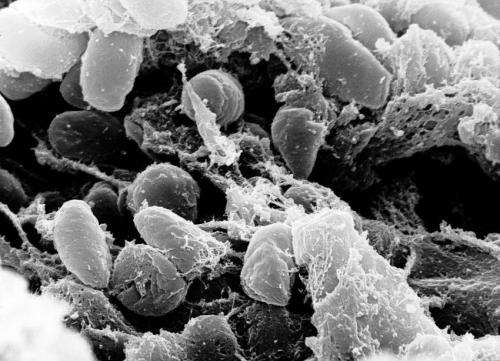Immune cells sacrifice themselves to protect us from invading bacteria

Immune systems are working overtime as winter approaches. Stomach flu can turn the strongest individual into a bedridden convalescent. Viruses are spreading in kindergartens. This year's flu is approaching in full swing. Knowing that a bunch of dedicated immune cells are willing to explode themselves to inform other cells about the danger may offer a bit of consolation.
But the flu is a strange thing. The same bacteria and viruses don't hit everyone with the same intensity. Some people get really sick, others less so. Why? What's really going on in the body when viruses and bacteria enter the body?
A lot of researchers are intrigued by that question. One of them is Professor Egil Lien at the Norwegian University of Science and Technology's (NTNU) Centre of Molecular Inflammation Research (CEMIR). He splits his time between Norway and the the University of Massachusetts in the United States, and is one of Norway's foremost experts on how bacteria attack people.
Lien hasn't chosen the easiest bacteria to study. He has opted to focus on a really nasty one called Yersinia pestis, the culprit behind the Black Death outbreak. Yes, the bacteria that killed a third of Europe's population in the 1300s. Lien has singled out this bacterium as a lifelong research partner because it is a very deceptive one. Yersinia manipulates the immune system to hide from it, and also kills cells that the body uses in the immune system.
Now, Lien, Ph.D. candidate Pontus Ørning and other research colleagues have made a new discovery about what happens in the body when bacteria like Yersinia and Salmonella are at peak activity. This information is relevant not only because Yersinia still exists and because antibiotic resistance is a growing problem, but because the new knowledge can be transferred to study other diseases. This knowledge can also be used to make more effective medicines. Their finding has been published in the November 30 issue of Science.
The researchers report that immune cells actually explode to release proteins that fight invading bacteria and resulting damage. The explosion also warns the other immune cells—they sacrifice themselves to let the other cells know what is going on. The process is so explosive that it is called pyroptosis.
What happens is that the immune cell forms small pores on its surface. This causes water to flow into the cell, which then swells until it bursts. When the cell explodes, it also releases substances that inhibit the invading bacteria from growing and that alert the other cells. Pretty effective, right?
Sneaky Yersinia knows all this, and tries to camouflage itself and secretes an antidote. The NTNU researchers figured out that the body knows that Yersinia disguises itself. The article in Science explains that the immune cells initiate a backup mechanism that is triggered in a way not previously understood.
"These findings show us complicated mechanisms that occur in the immune system to counter infection, but they may also apply to other diseases. Some of the same phenomena can happen in diseases that cause inflammation in the body in general, such as food poisoning or Alzheimer's disease. So these findings can also increase our understanding of inflammation, which happens in most diseases as changes occur in the body," says Lien.
More information: Pontus Orning et al, Pathogen blockade of TAK1 triggers caspase-8–dependent cleavage of gasdermin D and cell death, Science (2018). DOI: 10.1126/science.aau2818

















